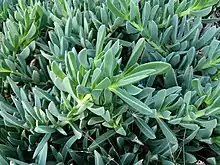Carpobrotus quadrifidus
Carpobrotus quadrifidus (commonly known as west-coast sourfig, Weskus suurvy) is a succulent perennial of the family Aizoaceae, native to the west coast of South Africa.
It has also been classed as Carpobrotus sauerae.
| Carpobrotus quadrifidus | |
|---|---|
 | |
| Scientific classification | |
| Kingdom: | Plantae |
| Clade: | Tracheophytes |
| Clade: | Angiosperms |
| Clade: | Eudicots |
| Order: | Caryophyllales |
| Family: | Aizoaceae |
| Genus: | Carpobrotus |
| Species: | C. quadrifidus |
| Binomial name | |
| Carpobrotus quadrifidus (L.) L. Bolus | |
The flowers of this Carpobrotus ("sour-fig") species range in colour from bright pink to white, and are the largest flowers produced by any species in its Mesembryanthemaceae family. The flowers appear in spring.

Its leaves are grey in colour. They are also stout, straight and have an isosceles triangle shape to their cross-section.
Their natural habitat is the low-lying coastal strip along the west coast of South Africa, as far south as Saldanha. Its fruits are edible and are grazed by tortoises and other southern African animals. [1]
References
- "Carpobrotus edulis | PlantZAfrica.com". www.plantzafrica.com. Retrieved 2018-10-26.
| Wikimedia Commons has media related to Carpobrotus quadrifidus. |
